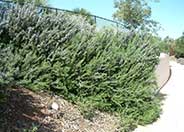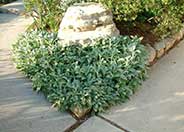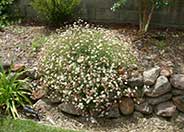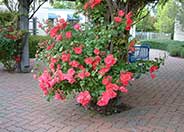
Common name:Rosemary
Botanical name:Rosmarinus officinalis
Rosemary is hardy in full sun areas where winter temperatures do not drop below 10 degrees F. They can be grown in a clay pot with well-drained, porous soil in bright indoor light, and will also flourish on the backporch in spring, summer and fall. Its beautiful, slowly trailing stems and shiny slender leaves are perfect for showing off the small, light blue flowers that blossom in the summer.

Common name:Lamb's Ears
Botanical name:Stachys byzantina
This tiny, herbaceous perennial will grow less than 1' tall and has medium sized, grayish green leaves with blue and lavender flowers that bloom in the spring.
Maintenance Tips
Stachys byzantina is a perennial with extremely soft, thick, fuzzy silver leaves. It has a mounding growth habit and grows about 6” tall with a spread of about 12” wide. It is a very low-maintenance plant. Old leaves near the bottom of the plant will fade and can be removed to give the plant a neater appearance. It will send out flowers on stalks in the spring that will last until summer. Once they have finished blooming, stalks should be cut off at the base where they attach to the foliage. They are susceptible to over-watering and have a lifespan of about 2-4 years in the garden, after which they can be divided into new plants or replaced with new ones.
Common name:Blue Fescue
Botanical name:Festuca glauca
This ground cover/grass will grow less than 1' tall and has small, blue green leaves.
Maintenance Tips
Festuca glauca is a perennial clump-forming grass. It has soft straw-like leaves that form a blue-green dome that can get up to about 10 inches wide and tall. They prefer full sun and well-drained soil, but can tolerate slight shade, drought conditions, and poor soil nutrition. These will send out flower stalks in the summer, which should be cut back to the base after a few months to give them a cleaner appearance. They will also benefit from having any dead leaves pulled from the plant at any time of year, but the fall is typically the best time to clean up the foliage. It is short-lived in the landscape, with a lifespan of about 2-4 years after which it dies out in the center. Some might dig up and divide the living edges into several new plants, but most of the time it is easier to replace with a new one.
Common name:Santa Barbara Daisy, Mexican Daisy
Botanical name:Erigeron karvinskianus
This low mounding perennial, with fine leaves and white to pinkish, daisy-like flowers, is an excellent asset to rock gardens.
Maintenance Tips
Erigeron karvinskianus is a very vigorous, spreading perennial that can get 12-18" tall and spread out to 5'. It is a very fast grower and is covered with pinkish-white flowers nearly year-round. It is fairly drought tolerant and can thrive in just about any soil conditions. This plant can often become invasive in small gardens because it spreads and can over-seed and easily overtake other plants. Maintenance on this plant is only considered low if it is planted in mass and not competing with other plants. If this is used in a small garden, it will require regular pruning to manage its size. It may also be necessary to apply pre-emergent throughout the garden to keep the seeds from germinating and overtaking the garden.
Common name:Bougainvillea, Barbara Karst
Botanical name:Bougainvillea 'Barbara Karst'
The large amount of flamboyant color on this species creates a wonderful accent in a garden. Varieties can be in bush or vine form; colors vary. Once established, they tend to be carefree. All varieties are susceptible to frost damage. The 'Barbara Karst' variety blooms bright red in full sun; more crimson if in shade. It blooms early and long. It is senstive to frost and will die back hard but comes back in a number of weeks. Be carefeul of this in the Santa Ynez Valley.

Common name:Tuscan Blue Upright Rosemary
Botanical name:Rosmarinus officinalis 'Tuscan Blue'
The Upright Rosemary is an upright shrub that grows 3'-6' tall. It has dark green leaves and bright, showy, lavender blue flowers throughout the year. This shrub is drought tolerant and attracts butterflies.

Common name:Climbing Rose
Botanical name:Rosa Climbing varieties
With its dark green foliage and fragrant flowers with full and double blooms, this upright shrub is generally grown as a vine or pillar rose. Climbing varieties come in many colors.

Common name:Spanish Lavender
Botanical name:Lavandula stoechas
This dense shrub grows 2'-3' tall with blue gray foliage and deep purple flowers that have large showy bracts near the top of the spikes. It is drought tolerant .

Common name:California Sycamore
Botanical name:Platanus racemosa
The California Sycamore is a fast growing deciduous tree that reaches up to 40'-50' high. It tolerates heat, smog, and drought conditions as well as moist conditions; it is native to riparian areas. It has interesting mottled bark when the tree is bare in winter.

Common name:Dome Euphorbia
Botanical name:Euphorbia characias
This perennial will reach about 4' tall and has blue green leaves with bright green flowers that bloom from late winter to early spring.

Common name:Western Redbud
Botanical name:Cercis occidentalis
This deciduous shrub or small tree ranges from 6'-10' tall and wide. It is desirable for its magenta spring flowers, yellow to red fall color, and dangling winter seed pods. It is tolerant of many soil types, drought and oak root fungus. It attracts hummingbirds and butterflies. The Western Redbud can be found statewide in CA in the foothills below 4500' elevations in chaparral and woodland communities.
Maintenance Tips
Cercis occidentalis is a very popular California native deciduous tree. The natural form of this plant is that of a multi-branching shrub; however, it is often shaped to be a single trunk so it can be used in many garden spaces. The best way to keep the maintenance low with this tree is to plant it in a sunny location that has well-drained soil and give it the room it needs to reach its mature size. It is fairly pest and disease-resistant and performs very well as a specimen tree in native gardens. The pruning recommendations will depend on the shape of the specimen. If the tree has the multi-trunk, shrub form, the mature height can be 6-10' tall and wide and will naturally grow into a round, compact form. These forms benefit greatly from the thinning method, removing cross-branching or the longer branches to manage the plant's size. The cuts should be made towards the center of the plant, allowing sunlight into the interior. The single trunk form should be pruned the same way, but it will mature much larger and eventually should be pruned by a licensed arborist. Both forms will lose their leaves in the winter, so this is usually the easiest time to prune since the foliage is out of the way.
Photographer: GardenSoft
Physical weed control, including mulching, or hand removal protects the watershed from harmful chemicals.
Adjust sprinklers to avoid watering sidewalks and driveways.
Drip and other smart irrigation delivers water directly to roots, allowing no excess water for weeds.